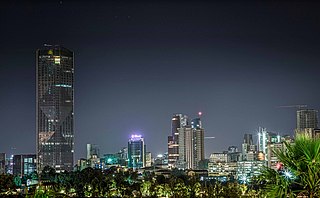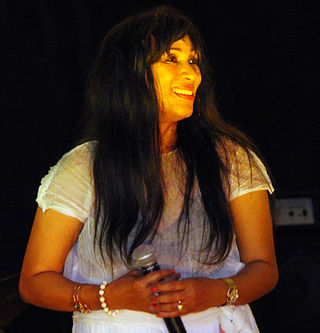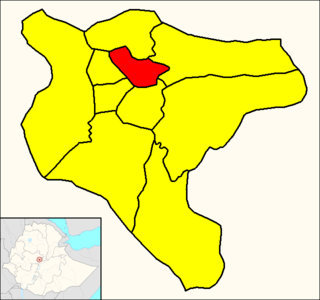Telecommunications in Ethiopia is a monopoly in the control of Ethio telecom, formerly the Ethiopian Telecommunications Corporation (ETC). As of 2012, 20.524 million cellular phones and 797,500 main line phones were in use.

Addis Ababa is the capital and largest city of Ethiopia. In the 2007 census, the city's population was estimated to be 2,739,551 inhabitants. Addis Ababa is a highly developed and important cultural, artistic, financial and administrative center of Ethiopia. It is widely known as one of Africa's major capitals.

Aster Aweke [ʔəsɨteɾɨ ʔəwək'ə] is an Ethiopian singer-songwriter. Aster's voice has attracted broader public popularity, especially tracing back in 1990s singles and her single "Abebayehosh" in Ethiopian New Year. She is best known for her 1999 album Hagere and her 2006 album Fikir. She moved to the United States in 1981, and she returned to Ethiopia in 1997.

Tilahun Gessesse was an Ethiopian singer regarded as one of the most popular Ethiopian artist of the 20th century. Noted by his tenor voice, he was nicknamed "The Voice" during his country's "Golden Age" in the 1960s. Tilahun was an eminent singer whose works are attributed legacy to Ethiopian music. Besides his popularity, he raised money for aid during the famines of the 1970s and 1980s and earned the affection of the nation, being awarded a doctorate degree by the Addis Ababa University and also winning a lifetime achievement award from the Ethiopian Fine Art and Mass Media Prize Trust.
Wolle Chekol was an Ethiopian statesman whose positions included Minister of Finance, Minister of Foreign Trade, and Deputy Prime Minister. He was born in Gojjam, where he completed his elementary and secondary education. He earned his BA degree in economics from Haile Selassie I University, Addis Ababa with distinction, and later earned an MA in Economics from the Center for Development Economics, Massachusetts, United States.
Kuku Sebsibe is an Ethiopian singer. She generally performs with synthesizer and drum machine accompaniment, occasionally with the addition of traditional instruments such as the krar or other instruments such as the electric guitar. While she uses modern instruments and harmonies, her vocal style is essentially traditional, using modes such as tizita.

Ethio Electric Sport Club, also known as EEPCO or Mebrat Hail, is an Ethiopian football club based in Addis Ababa. The club currently plays in the Ethiopian Higher League, the second division of Ethiopian football.
The Ethiopian Premier League, known as the BetKing Ethiopian Premier League for sponsorship reasons, is the top tier association football league of Ethiopia run by the Ethiopian Premier League Share Company. Established in 1997, it replaced the former first division. Contested by sixteen clubs, it operates on a system of promotion and relegation with the other secondary and tertiary leagues in Ethiopia. The league has been an annual competition since the 1997–98 season with Saint George emerging as the country's leading club in this era with 15 titles.

The Ethio-Djibouti Railway is a metre gauge railway in the Horn of Africa that once connected Addis Ababa to the port city of Djibouti. The operating company was also known as the Ethio-Djibouti Railways. The railway was built in 1894–1917 to connect the Ethiopian capital city to French Somaliland. During early operations, it provided landlocked Ethiopia with its only access to the sea. After World War II, the railway progressively fell into a state of disrepair due to competition from road transport.

Kirkos, also spelled Kerkos, Kirikos or Cherkos, is a district (sub-city) of Addis Ababa, Ethiopia. As of 2011 its population was 235,441.

Arada is a district (sub-city) of Addis Ababa, Ethiopia. Arada got its name from the Oromo "Ardaa Gabaa," meaning "Market Venue." "Ardaa" is a term the Oromo commonly use for places where folks from different directions gather. Initially, they also called it "Birbirsa Gooroo". Over time, the name evolved to signify an urban and modern life style. As of 2011 Arada's population was of 226,000. Arada is one of 10 districts of Addis Ababa, the capital of Ethiopia. Arada is a center of culture and education, with a great number of schools, cultural establishments and annual cultural events. Arada is one of the oldest parts of Addis Ababa and early history is most apparent. Its narrow, sloping streets are dotted with beautiful old one- and two-storey buildings variously adorned with verandas, pillars, bay windows and other decorations in accordance with Indian, Middle-Eastern and European styles. Despite that, there are newer areas. The district's heart is Piazza, a bustling commercial area centered on De Gaulle Square; the imposing city hall, the seat of the city government, built in 1965, and the octagonal neoclassical St Georges Cathedral, built to commemorate Emperor Menelik's defeat of the Italians in the battle of Adwa in 1896 and named after Ethiopia's patron saint Its bustling streets are dotted with stores and boutiques offering European clothing, jewelry, and a variety of other things at relatively greater rates than in other sections of the city.
Sixteen-year-old Ethiopian school girl Hanna Lalango died on 1 November 2014, succumbing to injuries from a brutal kidnapping and gang rape by five men. Hanna was kidnapped and held captive for several days in Addis Ababa. One of six children, she attended a private high school in Ayer Tena neighbourhood.
Abel Tilahun is an Ethiopian artist and filmmaker, who works across traditional and emerging art forms. At the heart of his work is a concern for both the cutting edge and the long arc of history.

The Addis Ababa–Djibouti Railway is a standard gauge international railway that serves as the backbone of the new Ethiopian National Railway Network. The railway was inaugurated by Prime Minister Hailemariam Desalegn on January 1, 2018. It provides landlocked Ethiopia with access to the sea, linking Ethiopia's capital of Addis Ababa with Djibouti and its Port of Doraleh. More than 95% of Ethiopia's trade passes through Djibouti, accounting for 70% of the activity at the Port of Djibouti.

Ethiopian News Network was an Ethiopian television channel based in Addis Ababa, Ethiopia. The channel was launched in 2016 on Nilesat. It was the first private station based in Ethiopia to be focused on news and politics outside of the national broadcaster EBC. ENN TV faced criticisms by several organizations for alleged use of misinformation and propaganda manipulation which led the channel to official closure on June 29, 2018.

Takele Uma Banti is an Ethiopian politician who is currently serving as the CEO of Ethio-Djibouti Railways since 2024. He was the Minister of Mines and Petroleum from 2020 to 2023. He also served as Mayor of Addis Ababa from 2018 to 2020.

Bitena is a town in Wolayita Zone, South Ethiopia Regional State, Ethiopia. It is administrative capital of Diguna Fango district of Wolayita Zone, Ethiopia. Bitena is located about 355 km away from Addis Ababa to the south on the path Addis-Hawassa-Dimtu-Sodo and 45 km away from Sodo, the capital of Wolaita Zone. It also specifically located between 22 km West of Dimtu town and 7 km northeast of Kercheche town. Bitena lies between 6°57'52.6"N 38°02'08.7"E.

Menelik Wossenachew was an Ethiopian singer who was known for his famous singles "Fikir Ayarejim", "Sukar Sukar" "Teyaqiyew Biaschegregn " and later "Gash Jembere".

Unity Park is an amusement park located in Arat Kilo district of Addis Ababa, in the compound of National Palace. Established in October 2019, it features a zoo and historical artifacts. Admission may be purchased by online services such as Ethio telecom or using Commercial Bank of Ethiopia or in person in the compound premises.














